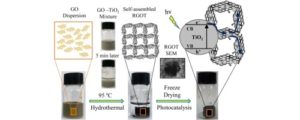Mohsin Nawaz, Waheed Miran, Jiseon Jang, Dae Sung Lee
In this study, the three-dimensional (3D) reduced graphene oxide/TiO2 (RGOT) aerogel was synthesized by a facile one-step hydrothermal treatment, and its photocatalytic efficiency was evaluated in the photodegradation of recalcitrant carbamazepine (CBZ) in aqueous solution. RGOT exhibited high adsorption and an almost two-fold higher photodegradation ability than bare TiO2 as more than 99% CBZ removal was observed within 90 min in 10 ppm aqueous solution of the latter. The mass ratio of TiO2 in the RGOT aerogel substantially affected CBZ adsorption and photocatalytic degradation, with the optimal TiO2/GO ratio in RGOT found to be 2:1. The chemical bonding between TiO2 and GO and the effective reduction of the latter during RGOT synthesis were also considered to achieve high photocatalytic efficiency, because the physical mixture of GO and TiO2 showed a lower photocatalytic CBZ degradation ability than bare TiO2. The macroporous 3D structure, abundant surface sites for anchoring the catalyst, effective charge separation, and mass transportation of CBZ near the photocatalyst surface are the attractive features of RGOT aerogels, promoting their use in resolving

… The UV irradiation intensity hitting the CBZ solution in the reactor was measured with a BLACK-comet concave grating spectrometer (StellarNet Inc., USA) and was found to be 13.5 ± 1 W m −2 in the range of 300–400 nm, with the peak wavelength at 365 nm. … environmental issues.





